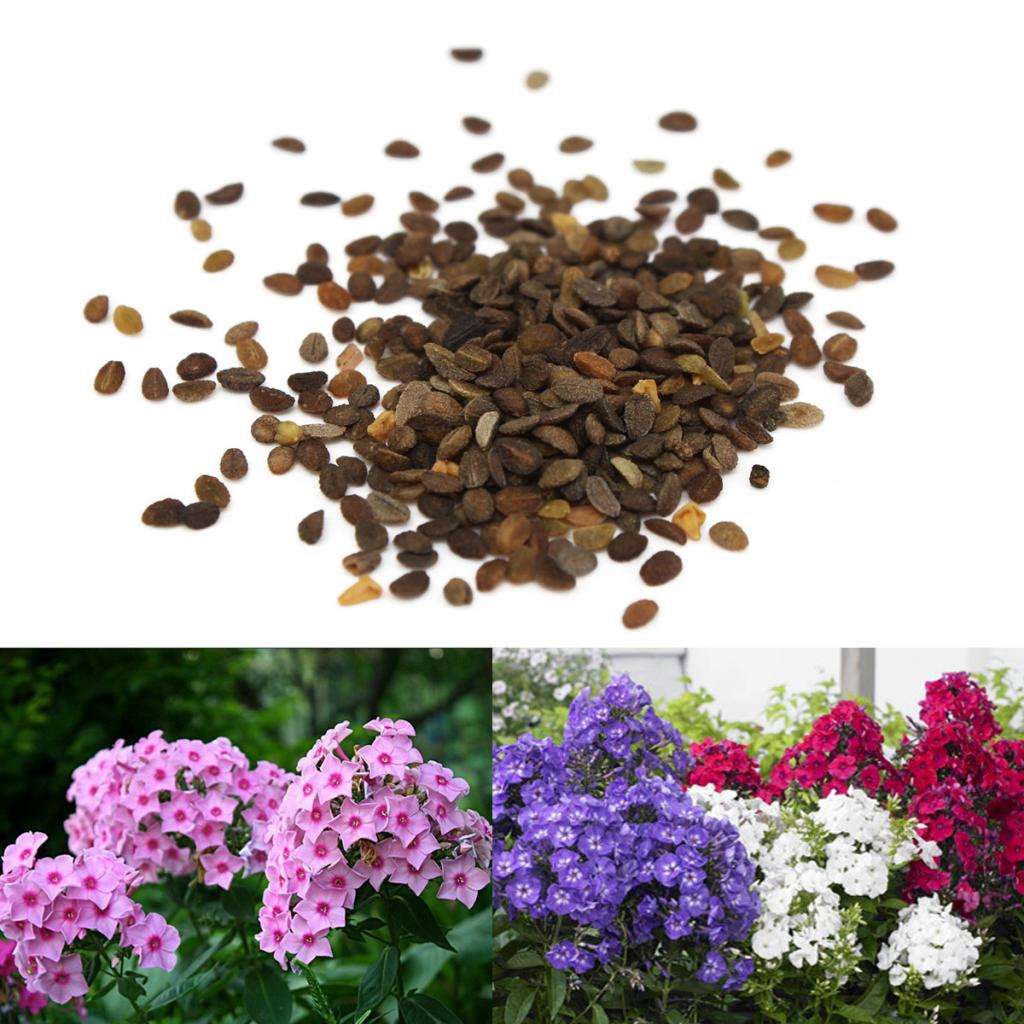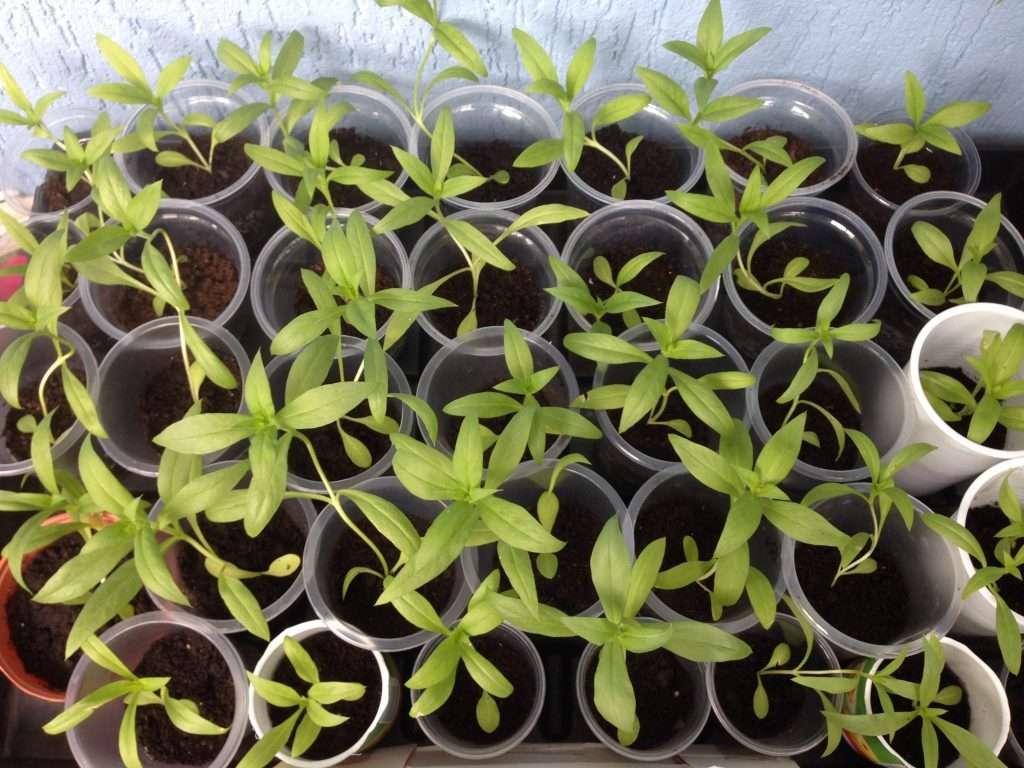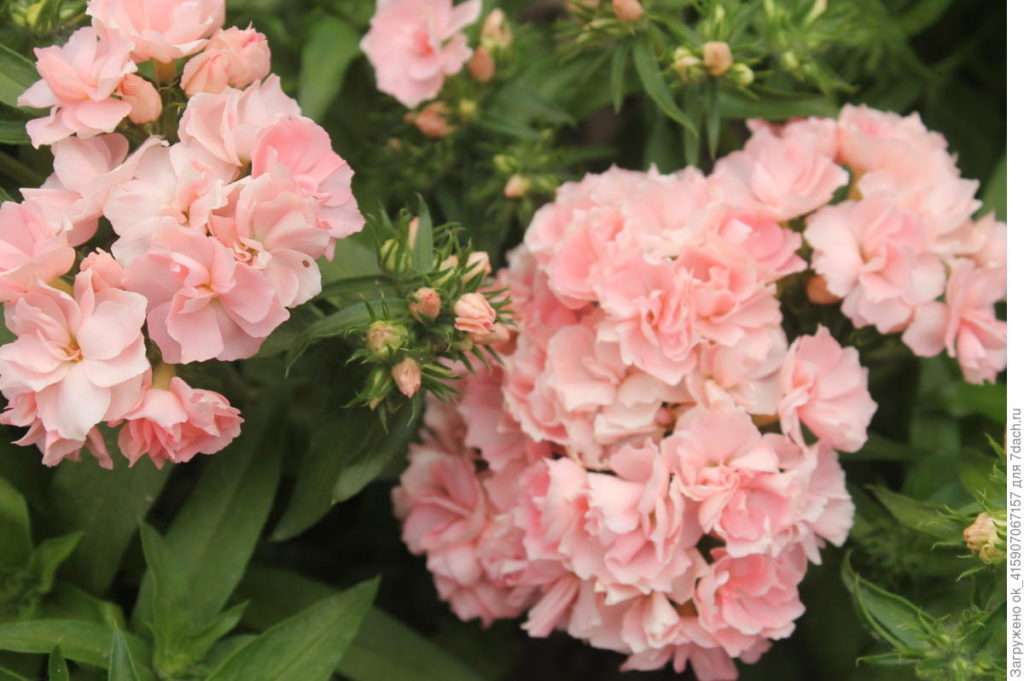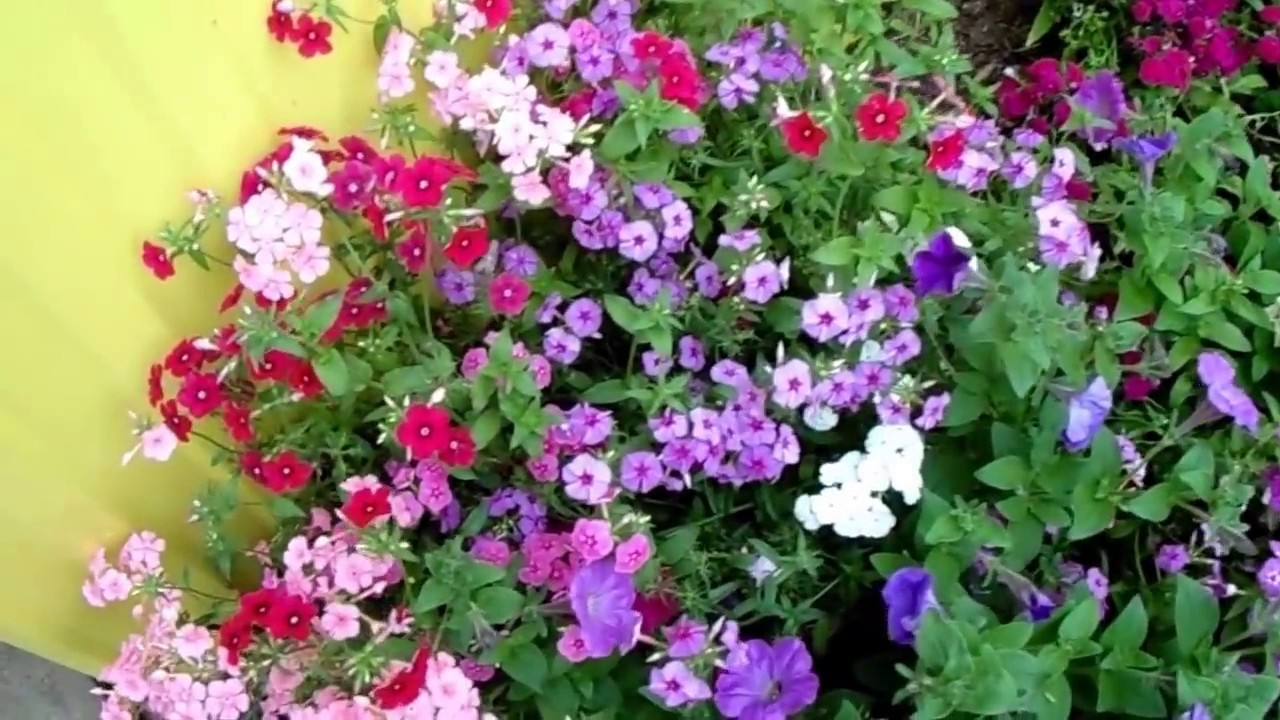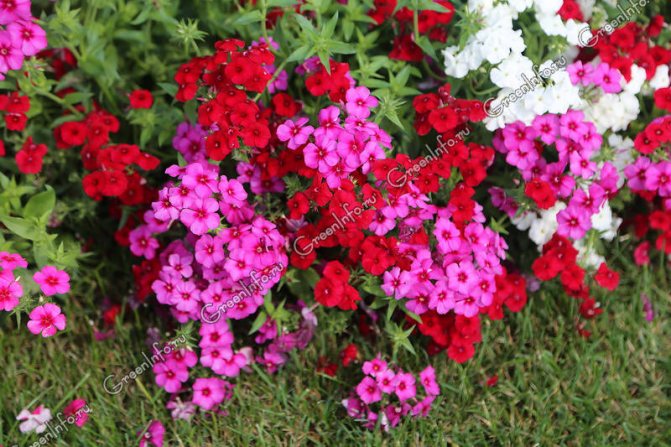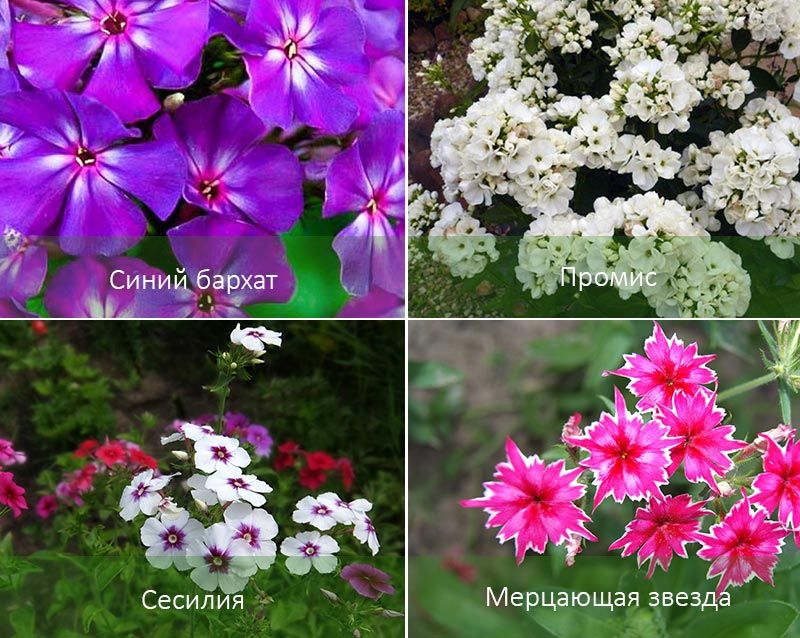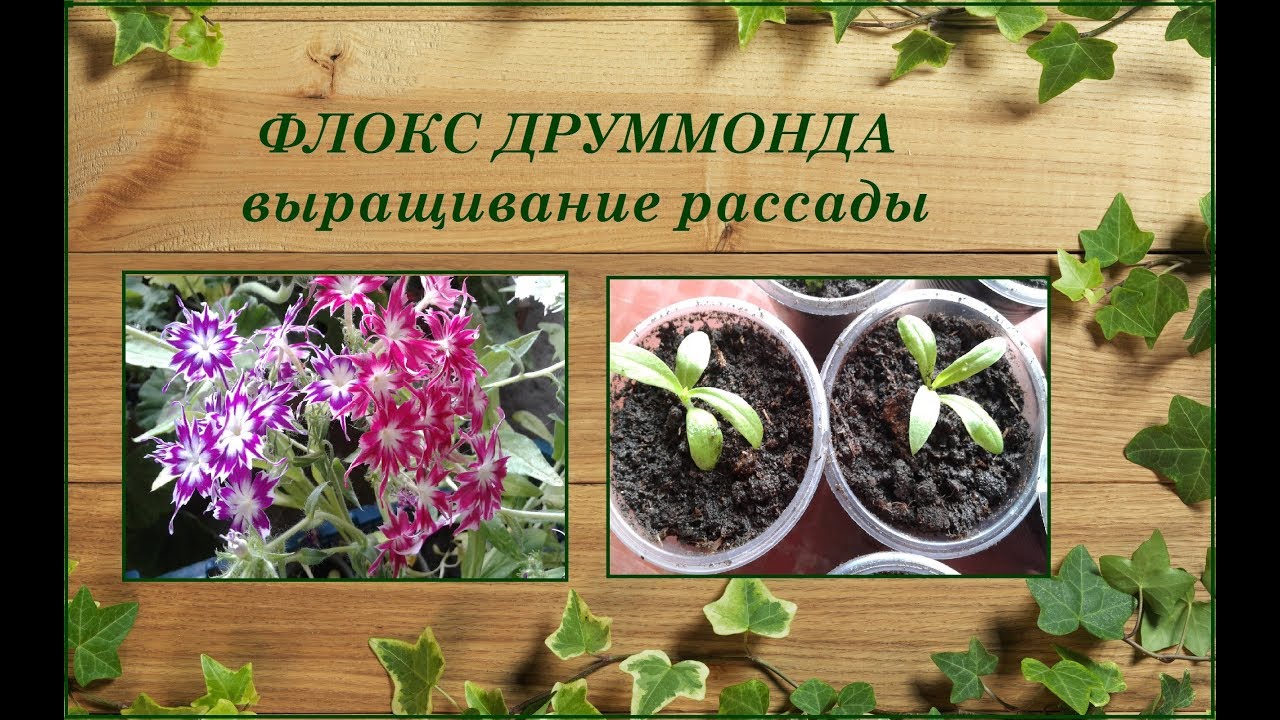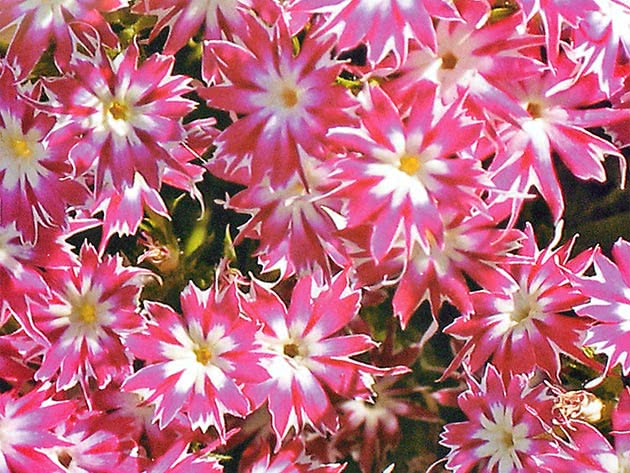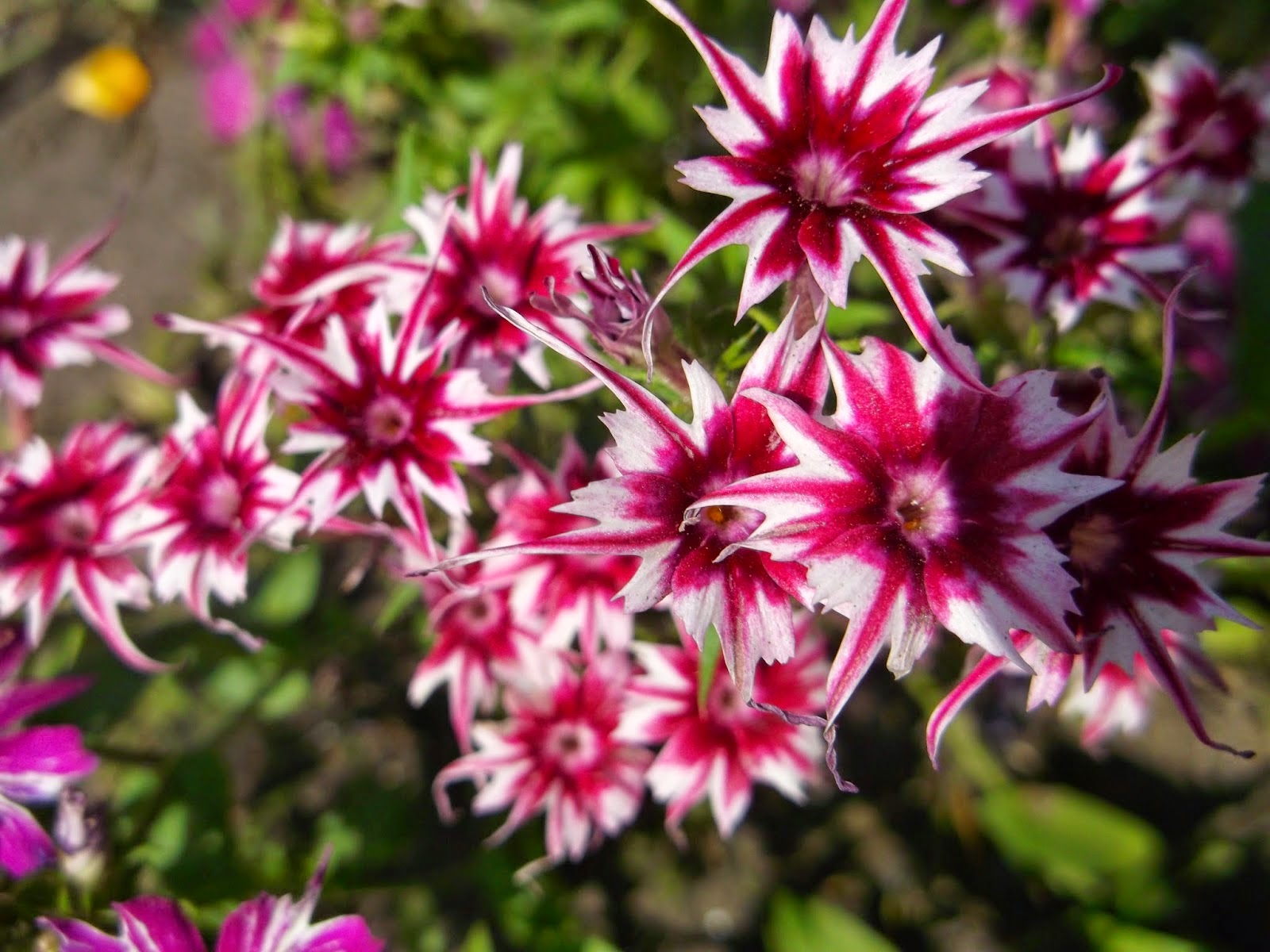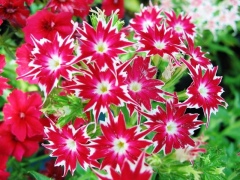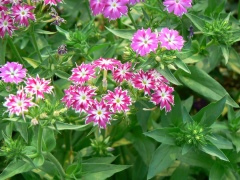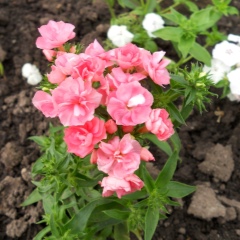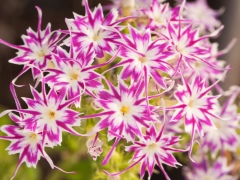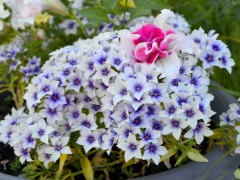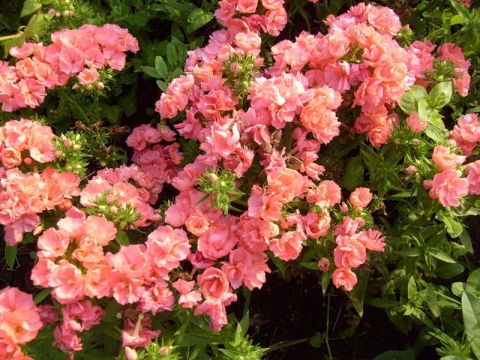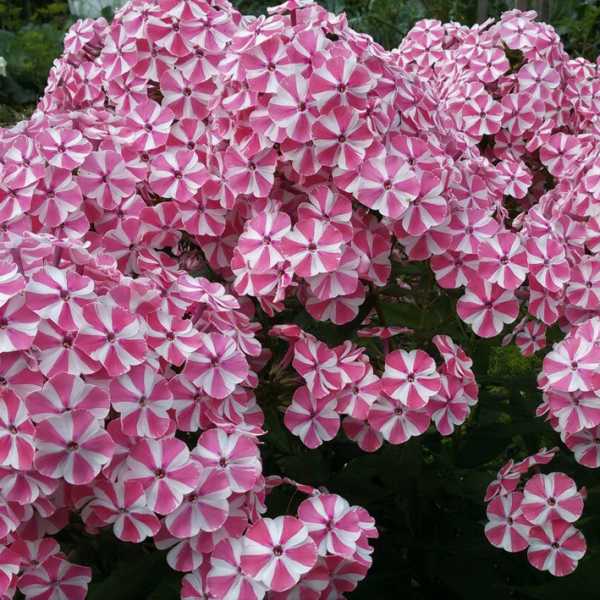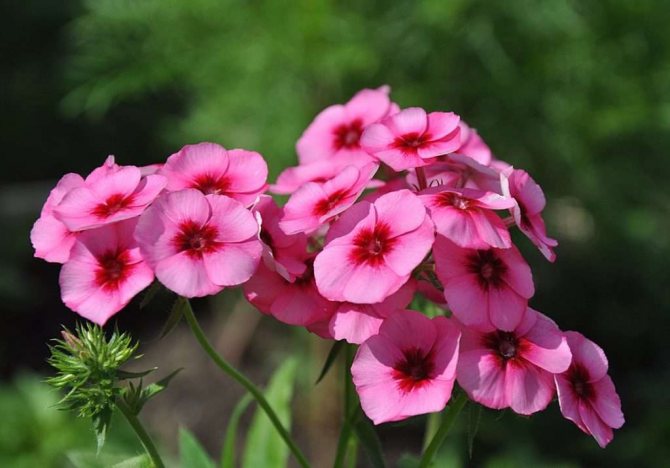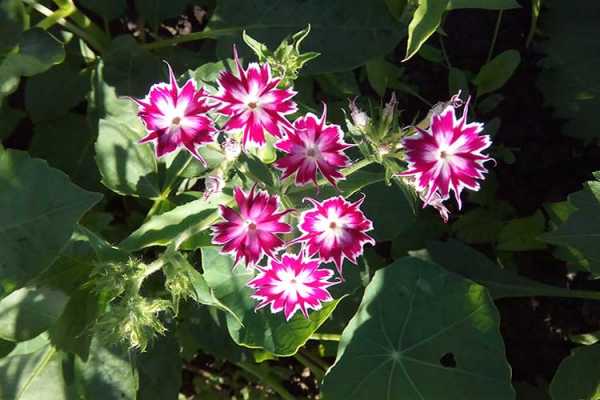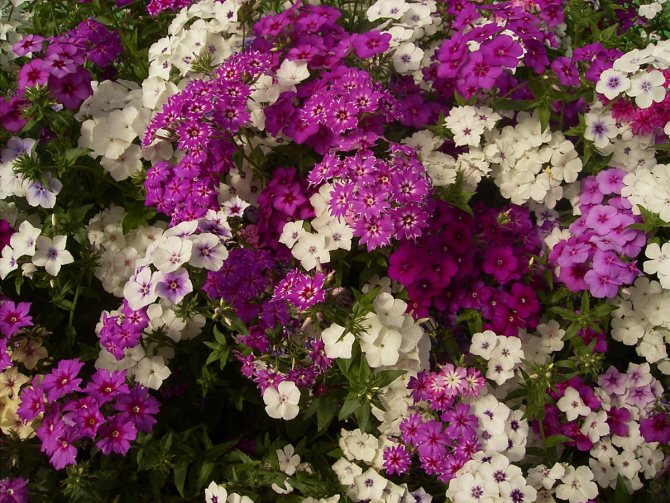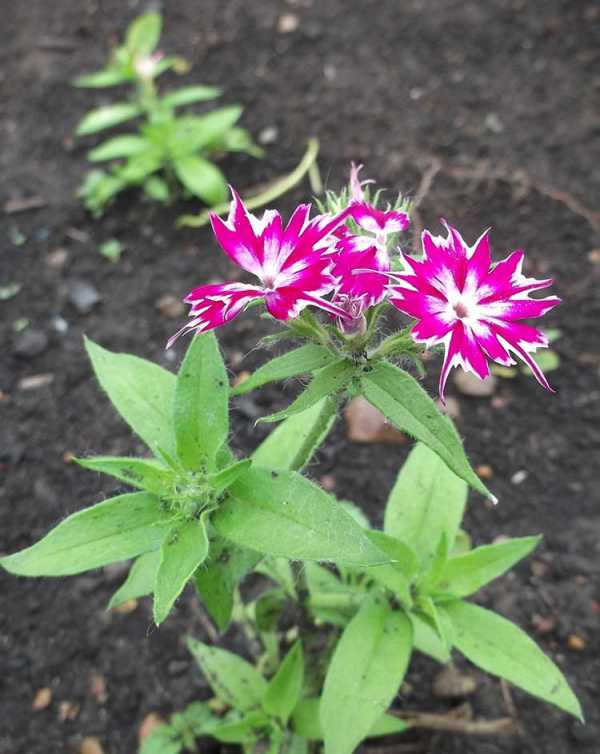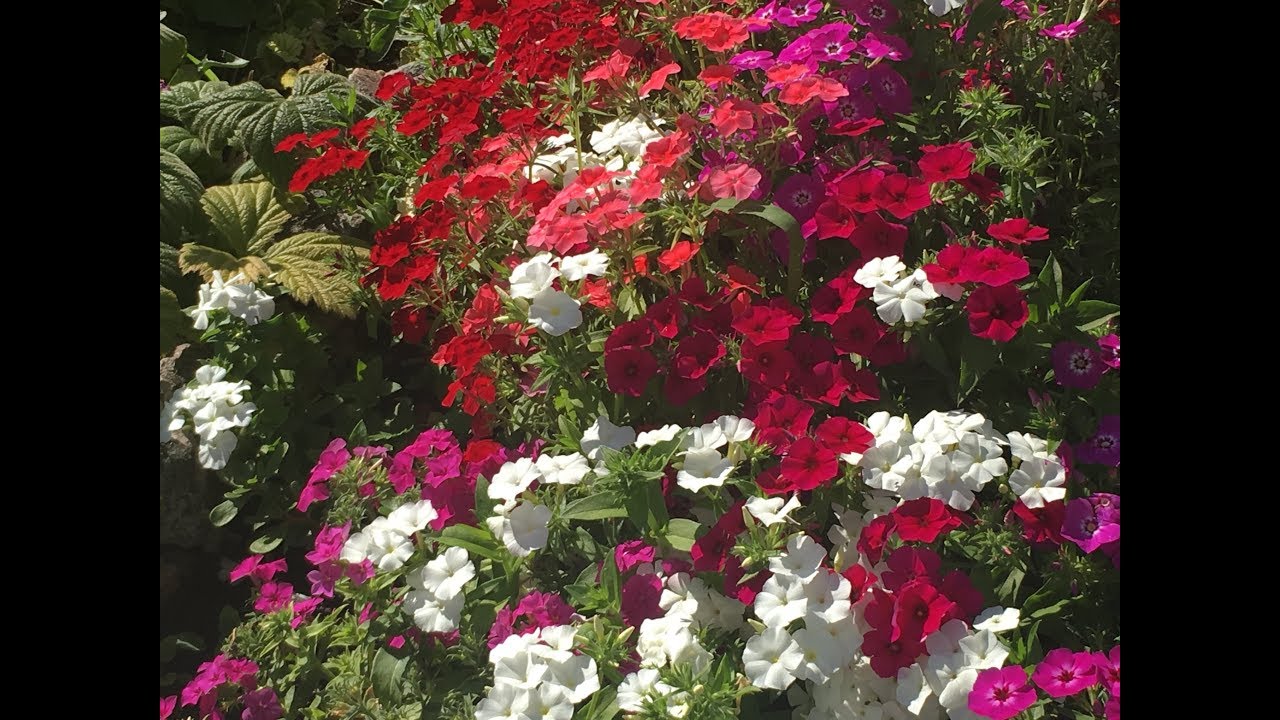Use in garden design
This annual blooms extremely richly and long-lastingly, with a whole scattering of fragrant flowers. He is not afraid of the first autumn frosts until they reach temperatures below -5 ° C.
The use of the plant is varied - in borders along paths, in flower beds, where it is combined with sparkling salvia, petunias and other crops. In containers and balcony boxes, Drummond's phlox, slightly drooping, forms bright caps of inflorescences. It gets along well with other container plants in ampel compositions.
Also suitable for cutting, bringing a wonderful aroma and rustic flavor to summer bouquets.
Drummond phlox care
Plants sown in open ground must be taken care of, because their appearance depends on it. At the same time, caring for Drummond's phlox is not too time consuming.
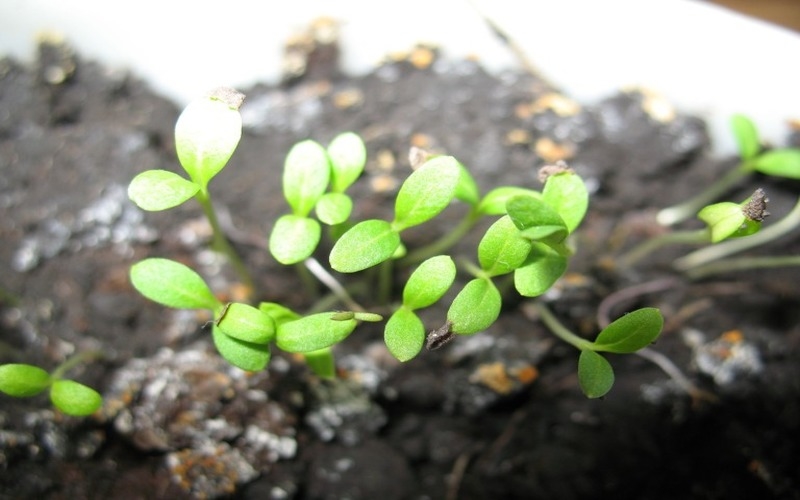
As soon as the first shoots hatch, they need to be taken care of. To do this, you need to carry out the following activities:
- Remove cover.
- Loosen the soil.
- Thin plants by removing excess (weak) ones.
- Feed the sprouts with nitrogen fertilization and use it in the future once every two weeks.
- When the first buds are formed, apply complex fertilizers, which should be applied twice a season.
Caring for a grown plant is not much different from caring for seedlings. It is based on the following procedures:
- watering;
- loosening;
- top dressing;
- removal of flowers.
Watering

In different periods of growth, Drummond's phlox is watered in different ways. At first, moderate and regular watering is required. Water consumption per meter area of bushes is about 10 liters. The liquid is poured closer to the stems, while it should not be cold, otherwise the roots of the plant will crack and it will dry out.
During the period of rapid flowering, the amount of water should be increased. Abundant watering is necessary for the root system of a blooming phlox, this will make its inflorescences lush and large, and the color of the petals bright.
Loosening
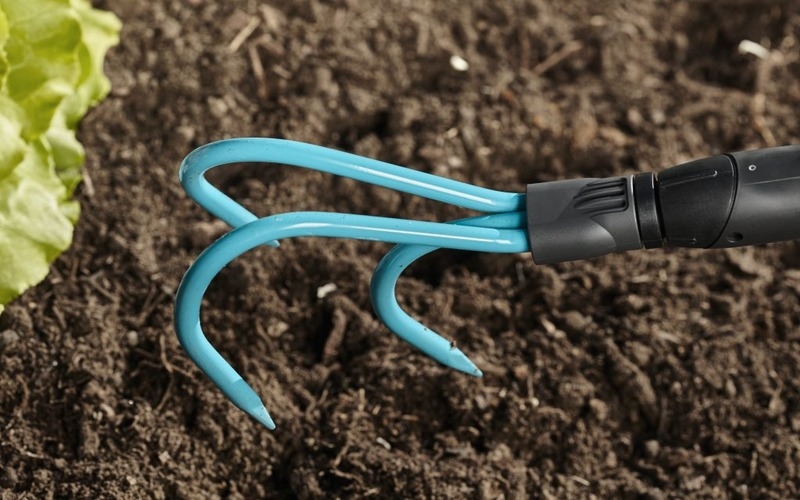
It is necessary to loosen the soil under the Drummond phlox bushes at least twice every 30 days throughout the entire flowering season. When the plant begins to bloom, you need to huddle to help the roots form correctly.
Top dressing: table of terms and types of fertilizers
Fertilizers are recommended to be applied in the following order:
| Period | How to fertilize |
| Last days of May | Manure diluted in water (for one bucket 30 g) |
| The beginning of June | Mineral feed containing potassium salt with superphosphate |
| In the early days of July | Complex fertilizer in combination with nitrogen |
| End of july | Mineral dressing with phosphorus |
Removing flowers
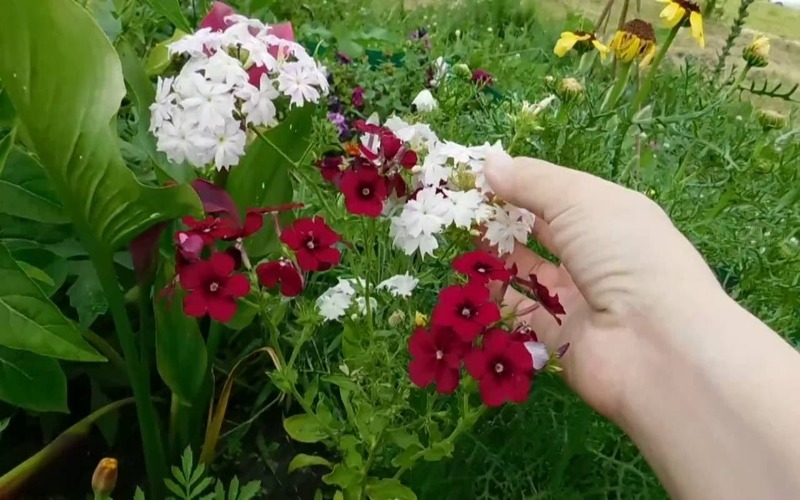
The most important measure is the removal of dried inflorescences or individual flowers. This is necessary for lush flowering, which will occur no later than 10 days after the procedure.
It should be remembered that Drummond phlox blooms in waves. During periods of drought, new flowers stop growing. Further growth can be triggered by cutting off old inflorescences and feeding with complex fertilizers.
Phlox Drummond is an unpretentious, but very beautiful plant that can become a real decoration of a flower bed and even a bouquet. It does not require much maintenance, but it is susceptible to some diseases. To prevent the plant from dying, it is necessary to carefully examine it for diseases, which include jaundice, powdery mildew, spotting, variegation, and nematode. Diseased plants should be immediately removed or treated with special preparations.
What does Drummond's phlox look like?
This flower is the only exception among the “relatives”. In contrast, it is an annual plant. But this feature does not affect the abundance of flowering and decorative culture of the culture.
In nature, it was most widespread in North America, especially in the southern states on the border with Mexico. Now its "wild" varieties are extremely rare.
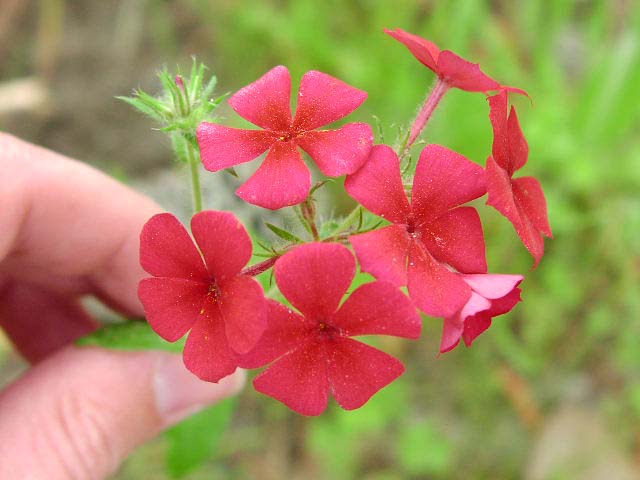
Drummond's "natural" phloxes in garden plots are very rare, almost never
The bushes are low (about 50 cm), but differ in the intensity of branching, which is unusual for a culture. Plants, propagating by self-seeding, form whole continuous "carpets" due to the splendor and multiplicity of inflorescences. The leaves are narrow and elongated, lanceolate. They are opposite on the stem.

Drummond phlox leaves are rather narrow, elongated
It blooms profusely and continuously. If it is grown by seedlings, the buds open already in June, when sowing seeds in open ground - about a month later. In the bright sun, the color of the petals does not "fade". The plant retains its decorative effect until the first frost. It can survive temperatures as low as -5 ° C. The buds in this case, of course, will suffer, but the leaves and stems will not, so the plant will quickly recover.
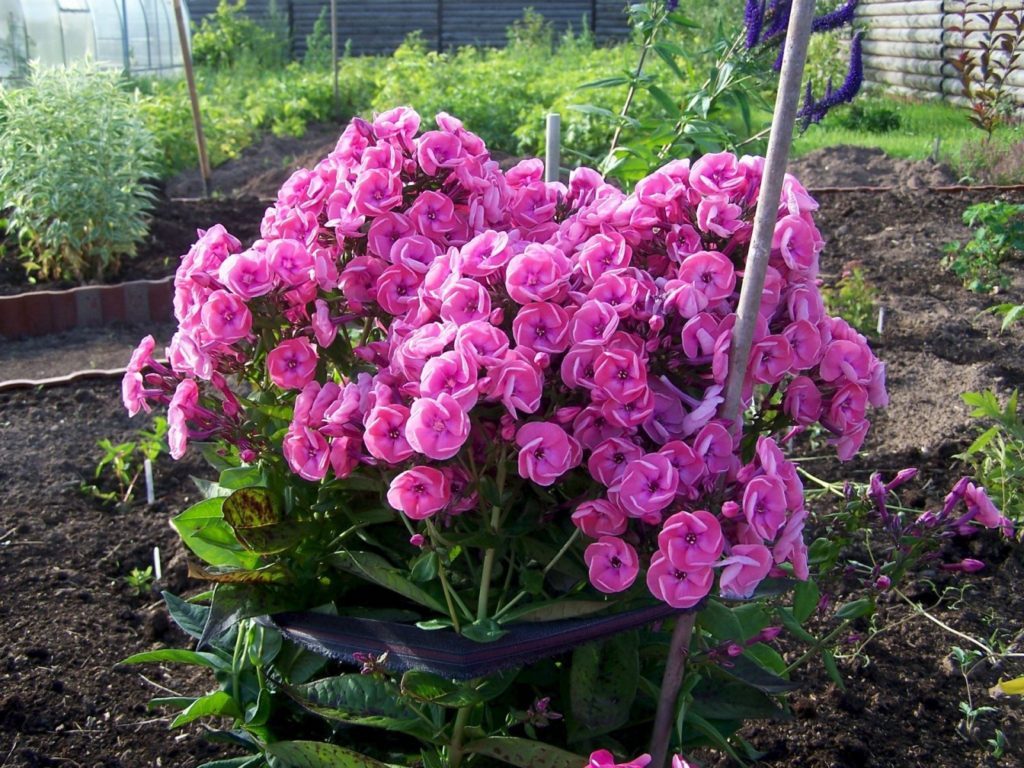
The bushes of Drummond phlox are low, but this does not affect the abundance of flowering.
The color gamut is very wide. The color of the petals ranges from pure white to dark cherry, including all sorts of shades of pink and red. Also, Drummond phloxes can be blue, blue, lilac, purple. The only exception is yellow. Such phloxes do not exist in nature, and breeders have not yet succeeded in achieving this shade. But varieties with two-color petals and "patterns" on them, as well as terry ones, have been bred. In addition to the "classic" rounded shape, the petals can be pointed, narrow, as if "cut" along the edges, with a tip resembling a needle.

Individual achievements of breeders are very little like the "wild" phlox of Drummond
Inflorescences in the form of a shield or umbrella. Separately, the flowers are rather small (on average 20–25 mm), but the diameter of the entire inflorescence reaches 12–15 cm. The lifespan of each bud is short (7–8 days), new ones are constantly revealed.
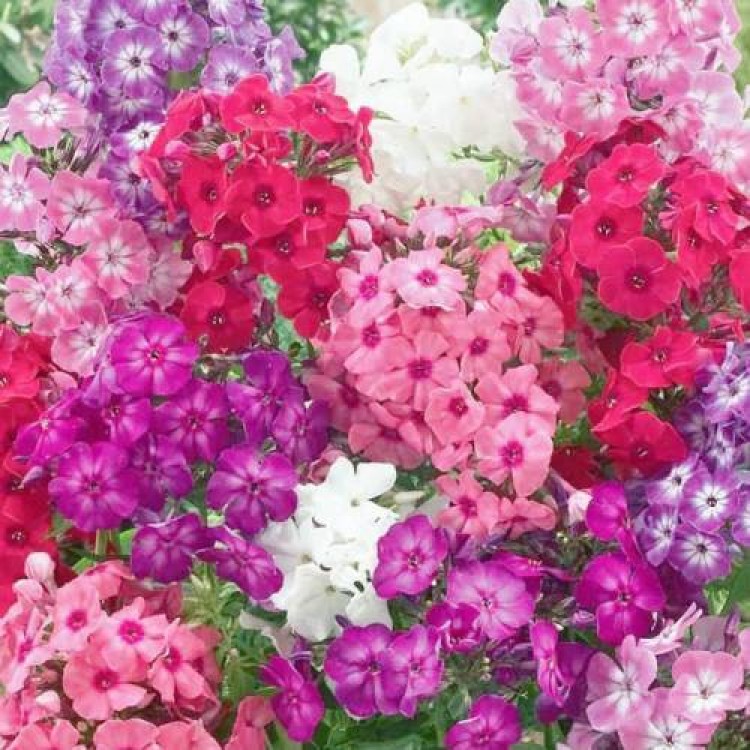
Even non-double Drummond phlox varieties look very cute.
The culture is widely used in landscape design. Low-growing varieties are ideal for decorating borders, they are also planted in hanging pots and containers, decorative flowerpots. The plant also looks good in group compositions, especially with tulips, daffodils and other bulbs that do not differ in the duration of flowering. Also suitable "companions" are bells, matthiola, bindweed, snapdragon, decorative flax, echinacea, catnip. Often, Drummond's phloxes are planted in rock gardens and in multi-tiered flower beds. You can also create a multi-colored "carpet". Such a flower bed looks especially impressive if you combine several shades with each other.

Phlox Drummond look very impressive, covering a large area with a solid carpet
In addition to the general decorativeness and duration of flowering, Drummond's phlox has a number of other indisputable advantages - undemanding care, good immunity (the plant rarely suffers from diseases and is attacked by pests), drought and cold resistance, the possibility of planting seeds in open ground and for seedlings, easy reproduction self-seeding.
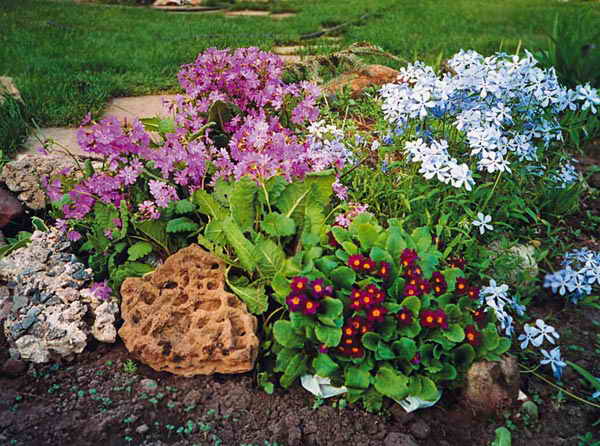
Phlox Drummond in a flower bed go well with any low-growing plants
Growing phlox Drummond
The soil. In order for Drummond's phlox to bloom profusely, he needs to allocate a sunny place. In the shade, the plant stretches out and forms few buds. The best option for it is sandy loam or loose fertile soil (although the plant also tolerates sandy soils), which are close to neutral or alkaline in acidity (pH 6.1-7.8).
Watering.Watering the plant needs constant and moderate watering, the plant stops blooming from drought, the flowers burn out in the sun at temperatures above + 29 ° C. Among the many varieties, there are more and less drought tolerant. Varieties with star-shaped flowers are especially sensitive to it.
The care is simple - weeding, watering and feeding with complex mineral fertilizer every 2 weeks. Manure is contraindicated.
Since the superficial root system of this phlox reacts to overheating, mulching will not be superfluous.
In container plants, faded inflorescences are cut off.
How and when to plant phlox seedlings. How to grow good seedlings of annual phlox from seeds
How to plant phlox seeds for seedlings - the most popular varieties and a detailed description of the process of growing seedlings of annual phlox.
Annual phloxes are very beautiful, vibrant plants with abundant flowering.
That is why experienced and novice flower growers prefer to grow them in their flower beds.
Due to the many shades, colorful and long flowering, as well as ease of care, annual phlox have gained great popularity.
Caring for it is quite simple, and with a competent approach, anyone can grow it, even without experience in gardening.
Annual phloxes are grown in two ways:
- Through seedlings
- Sowing seeds in open ground.
In this article, we will analyze in detail the seedling method - how to plant phlox seeds for seedlings correctly, but for now we suggest that you familiarize yourself with useful information on growing these magnificent flowers, which will definitely come in handy!
How to plant phlox seeds for seedlings?
Many novice gardeners are interested in how to grow phlox seedlings so that the plant turns out to be strong enough and bloom for a long time.
So, let's take a look at the main points:
When to plant phlox seeds for seedlings?
It is best to start sowing around mid-March (March 13 -18), and the very first shoots can be observed after 7 days.
Checking seeds for germination and de-freezing
Before planting seeds, you need to sort them and test for germination.
You need to leave only full-fledged and large ones.
To check their germination, sorting is carried out in a strong solution of potassium permanganate, to which you need to add a little table salt.
This will further achieve decontamination.
Seeds should be poured into the prepared solution in small portions, stirring thoroughly, and then kept for 10-15 minutes.
The seeds that have floated to the surface must be removed, and those that settle to the bottom - strain through a cloth or sieve, then rinse 2 times in water and dry, sprinkling with a thin layer on paper.
Soil for growing phlox seedlings
The quality and composition of the land used is very important. It is important that the soil is loose, with a low level of acidity, medium loamy
It is important that the soil is loose, with a low level of acidity, and medium loamy. For about 2-3 days, you need to slightly moisten the soil and keep it constantly moist.
For about 2-3 days, you need to slightly moisten the soil and keep it constantly moist.
Since phloxes have a fairly powerful rhizome, you need to choose a sufficiently deep container for growing seedlings.
When do phlox seedlings dive?
As soon as 4 strong leaves appear on growth, they need to dive.
With the onset of warmth (in April), the box needs to be exposed outside for several hours (so that the flower gets used to it and gets stronger).
When to plant phlox seedlings in the ground?
This is done in the second decade of May in a previously prepared flower bed.
After the sprouts are planted, they need to take root and then fertilizer can be applied.
Such a simple method of sowing seeds and germinating seedlings gives very good results, since the plants grow strong and you can achieve very beautiful, long-lasting flowering that will be mesmerizing.
How to plant seeds in the ground
When sowing seeds, certain rules must be followed:
- spread them out on the surface of the earth;
- water using a spray bottle;
- put glass or stretch the film;
- put in a well-lit room;
- remove film or glass every morning to eliminate condensation.
The first watering after planting the seeds should be done every other day.
When growing, it is very important to ensure the greenhouse effect. The room temperature must be at least 20 degrees, and high humidity is also required
The room temperature must be at least 20 degrees, and high humidity is also required.
It is best to place containers with slightly grown seedlings on the windowsill, since there is a lot of light there.
It is quite simple to take care of the plant, the most important thing is to make sure that the earth does not dry out, in moderation, but regularly water it, and you also need to periodically apply organic fertilizers.
1 Description and varieties of phlox
Phloxes belong to herbaceous crops from the Sinyukhov family and are similar in description to hydrangea. The appearance of representatives of this genus differs even within the same species. The characteristics change depending on the climatic conditions. For example, at an altitude of 4 km, mostly stunted and bryophytes grow. They have branched stems and evergreen leaves. The culture reaches a height of 5-25 cm.In more favorable conditions, upright bushes with a height of 30-180 cm can be found.
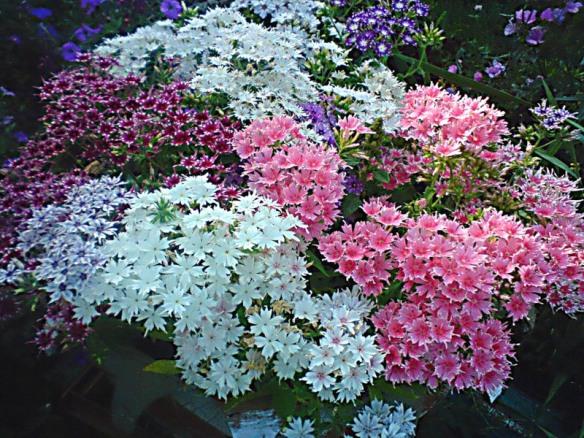
Most phloxes have an erect stem shape. The foliage is located opposite, the edges are solid. In shape, the leaves are oval-lanceolate or oblong ovoid. Flowers are about 2.5-4 cm in diameter. They are collected in complex inflorescences of 90 pieces. The fruit looks like an oval capsule.
The following plant varieties are distinguished:
- 1. Star rain. The variety is resistant to drought and frost. Its representatives bloom for a long time. The plant looks like a shrub up to 0.5 m in height with a straight stem that branches strongly. Inflorescences in the form of brushes, have a pleasant smell. The flowers are star-shaped. For this kind, you need to choose a bright place.
- 2. A blinking star. The culture is a small shrub up to 25 cm high. The difference is the pointed petals. Due to its small size, the plant is grown not only in the open field, but also at home. For example, you can plant them in a pots and leave them on the balcony, windowsill. The flowering period lasts from early summer to late September.
- 3. Terry phlox. The variety has appeared relatively recently. It is named so because of the unusual structure of the petals. The shrub itself is 20-30 cm high. It is covered with large inflorescences that have the shape of shields. Their shades are very different: white, pink, cherry. This crop is also great for growing in pots.
- 4. Constellation. The variety has light and bright colors. Inflorescences are no more than 3 cm in size. They have a pleasant fragrant smell. The plant is highly branched. Inflorescences are in the form of scutes. Usually this variety is used to create bouquets, as well as for growing in groups in the garden.
Still undersized annual phlox are distinguished. They grow to a height of only 20 cm. They look like branched shrubs, their foliage is pubescent. These varieties are great for growing on windowsills, balconies. An example is Promis Pink: terry inflorescences, have a pink tint. This variety is usually used for flower beds in gardens and for decorating rockeries.
The best conditions for growth
By their nature, phloxes are a very picky and grateful plant.But if you want to get strong seedlings and the most lush flowering, then you need to provide optimal conditions for growing this crop.
| Conditions | Care Tips |
| Temperature | The optimum temperature for growing at the initial stage from the moment of sowing to the appearance of the first shoots is 23-25 degrees Celsius. But after the first shoots appear, this indicator is reduced to 20 degrees. |
| Humidity | In order for the seeds to germinate, they must be placed in a humid environment. To do this, cover the crop with dense plastic wrap or transparent glass, which will create a sustainable greenhouse effect. At the same time, decay is not excluded, therefore, such a mini-greenhouse must be aired daily for at least 15-20 minutes. In addition, after germination, the film is generally removed, since there is no need for it. |
| Watering | At the initial stage, the soil is subjected to daily spraying from a spray bottle. Further, when the sprouts are already well marked, a syringe pear is used, with the help of which it is possible to qualitatively moisten the soil ball without touching the seedlings themselves. |
| Lighting | Since for the full development of seedlings, a long daylight hours from 12 to 14 hours are required, and its cultivation occurs at the end of winter and the first two months of spring, it is necessary to take care of high-quality supplementary lighting. |
In general, phlox seeds, provided that we are talking about high-quality, non-expired material, have good germination, and compliance with all the conditions given in the table allows you to count on an excellent result.
Features of growing annual phlox
Growing phlox annuals is not a troublesome business, but it also needs to be approached with responsibility.
In order for the plant to please with abundant flowering, you need to plant it in a sun-drenched area.
The soil should be fertilized.
Such as peat or humus.
There are two ways to grow a culture:
- Using seeds directly into the ground. A good time to plant is early May. Before sowing, the soil must be prepared. After that, small holes are made, and several seeds are placed in each. It is necessary to plant so that the holes are at a distance of 15 cm from each other. The sprouts will appear 2 weeks after sowing. During these 2 weeks, the soil should be moist. And after the emergence of shoots, you need to do the loosening of the earth and liquid nitrogenous top dressing. It is necessary to feed the plant once a week. And in July, when the first buds begin to form, the soil should be equipped with any complex fertilizer for flowers.
- With the help of seedlings. This sowing method will give you the opportunity to admire the flowers as early as May. To do this, in mid-March, it is necessary to sow seeds in the boxes. Moreover, they are buried in the ground, but only slightly sprinkled. After sowing, the box must be covered with polyethylene, but we must not forget about daily ventilation. In a week, the first shoots will appear, and then you need to move the box to a bright place. Then the seedlings must be fertilized with liquid nitrogen, and with the onset of heat (in April), the box must be put outside for several hours (so that the flower gets used to it and gets stronger). In May, when the weather has already settled and it is warm outside, the seedlings can be planted in open ground.
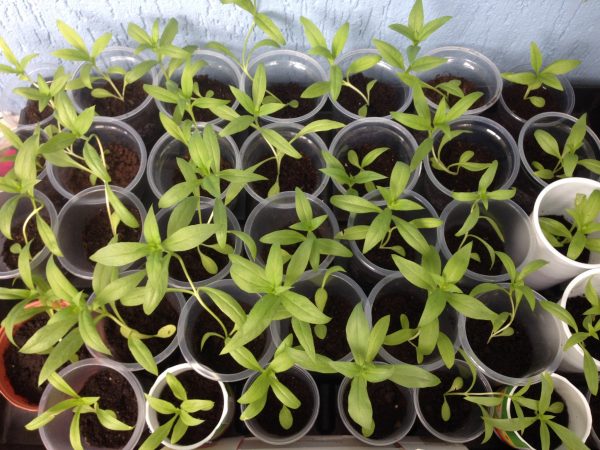
Annual phlox seedlings
Phlox Drummond is not capricious.
It has simplicity and unpretentiousness.
The plant does not need special care, but they are demanding for watering, especially during the period of growth and budding.
During the growing season, plants need to be fed and weeded.
For better tillering, it is recommended to pinch over the fourth pair of leaves.
Where to plant annual phlox?
The flower is ideal for decorating paths, lawns, alleys, hedges, balconies, loggias, flower beds and borders.
Phloxes look like beautiful variegated bedspreads that will take your breath away.
They are a real boon for landscape design.
The plant goes well with flowers such as:
- bells;
- decorative cereals;
- nivyaniki;
- veronica.
Phlox diseases
The most common phlox disease is powdery mildew.
This disease mainly affects the leaves and stems, at first a white-brown bloom appears, and then the leaves almost all become dark brown, which negatively affects the decorative effect and causes a weak flowering.
In conclusion, it should be noted that an annual phlox is not worse than a perennial one.
You can even say that it is better.
Indeed, unlike perennials, annuals are striking in their rich color.
Annual phloxes are not whimsical or capricious.
He does not need special care.
It is for such qualities that gardeners love him so much.
Beautiful garden to you !!!
Save the article on your favorite social network so as not to lose:

